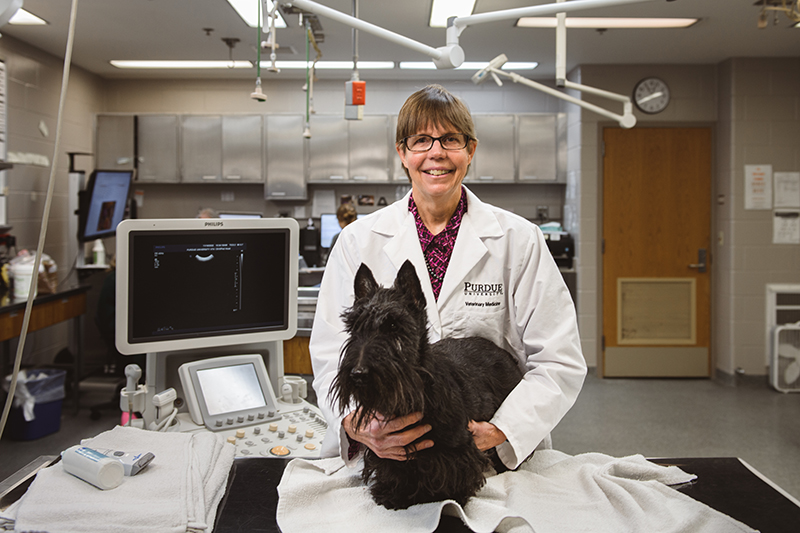Exposure to cigarette smoke increases cancer risk in dogs
A long-term study following Scottish terriers indicates cigarette smoke exposure leads to a sixfold increase in the risk of bladder cancer

Veterinary oncologist Deborah Knapp studies cancer in Scottish terriers to help advance the science of detecting and treating early cancer in both humans and dogs. (Purdue University photo/Rebecca Robinos)
WEST LAFAYETTE, Ind. —
Dogs are humans’ best friends. Need to quickly locate a bomb? There’s a dog for that. Can’t see very well? There’s a dog for that. Searching for a lost hiker in the mountains or survivors in an earthquake, diagnosing illness, comforting the bereft — there are dogs for every need.
They are even helping humans track down the causes of cancer. A new study links cigarette smoke exposure to an exponentially higher rate of bladder cancer in Scottish terriers. By assessing individual dogs and studying their medical history, scientists are beginning to untangle the question of who gets cancer and why, and how best to detect, treat and prevent cancer.
Led by Purdue veterinarian Deborah Knapp, a team of researchers tracked a cohort of 120 Scottish terriers over a three-year period. In a paper published in The Veterinary Journal, they found that dogs exposed to cigarette smoke were six times more likely to develop bladder cancer than those that were not. Knapp is a Purdue Distinguished Professor of Comparative Oncology, the Dolores L. McCall Professor of Veterinary Medicine, director of Purdue’s Evan and Sue Ann Werling Comparative Oncology Research Center, and a program co-leader in the Purdue Institute for Cancer Research.
“Cancer is a combination of what you are born with — your genetics — and what you are exposed to — your environment,” Knapp said. “In this case, we studied these dogs for years at a time, and then we went back and asked, ‘What was different between those that developed cancer and those that did not develop cancer? What were the risk factors?’”
Additional Information
Scottish terriers, famous for being presidential pets to presidents George W. Bush and Franklin D. Roosevelt, “Jock” in Disney’s “Lady and the Tramp,” and the cutest Monopoly game token, are also notable for a less cheerful reason: They develop bladder cancer at a rate 20 times higher than that of other dog breeds. And when Scotties and other dogs develop bladder cancer, it is often an aggressive form similar to muscle invasive bladder cancer in humans.
Knapp’s team studied 120 Scotties, assessing their health, environment, food, activity, locations and anything they could think of that might affect their cancer risk. The goal was both to figure out what could prevent a heartbreaking and often fatal cancer in this breed, but also to use that information to see what might affect cancer in other dogs and even humans. Dogs make an excellent study species because they live alongside humans, sharing food, bedding, housing, atmosphere and almost everything else.
“We know that Scotties’ genetics play a huge role in making them vulnerable to cancer,” Knapp said. That strong genetic signal tied to cancer helps researchers isolate other factors that affect the likelihood of any dog, or human, getting cancer, and to do so with smaller numbers of dogs. “If we were to do this study with mixed breeds of dogs, it would take hundreds and hundreds of dogs to uncover this same risk, which is probably there, just more difficult to discern because those dogs are not already inclined genetically to get bladder cancer.”
The researchers, with the help of Purdue alumna, veterinarian and Scottish terrier breed champion Marcia Dawson, wanted to study cancer in Scotties to help the dogs themselves and for what that research might reveal about canine and human risk factors overall.
When a dog (or human) is exposed to tobacco smoke, either by breathing it or by licking clothes saturated with the scent, their body takes up the chemicals in the smoke and eliminates them through the urine. This leads to cancer in the urinary tract, but also offers a way to assess smoke exposure. The researchers analyzed the dogs’ urine for a nicotine metabolite, cotinine, and its presence indicated the dog had been exposed to significant amounts of tobacco smoke.
Any time tobacco smoke is present in the same room as a dog, the dog breathes in the smoke. However, some dogs also had cotinine in their urine when their owners did not smoke. In that case, the dog could have been exposed away from the home. Or it may be that their owners visited places where others were smoking and returned home with smoke on their clothes.
“If someone goes out to a smoky concert or party, then comes home and their dog hops up on their lap to snuggle with them, the dog can be exposed to the particulate material in smoke through the person’s clothing,” Knapp said.
The results are not all black and white. Not all the dogs who were around smokers got cancer, and some dogs who were not around the smoke still got cancer. This is also true in humans. Half of human bladder cancer is due to smoking, but not all smokers develop bladder cancer. This discovery gives the Purdue team the opportunity to study how the combined effects of the genetics inherited from the parents plus environmental exposures lead to cancer.
Knapp stresses that this discovery is a new one. Dog owners, who almost universally want the best for their dog and wish their dog would live to be 100, certainly did not knowingly put their dogs at risk of cancer by smoking around them. However, with this new information, they may be able to better protect their pets going forward.
In another interesting finding, the researchers did not uncover a link between lawn chemicals and bladder cancer, which had been found in previous studies. “That’s likely because we are working with pet owners who are aware of the risk of lawn chemicals, so they took precautions to keep the dogs safe, like not treating parts of the lawn where the dog tends to be or keeping the dogs off the lawn for longer,” Knapp said. “That is encouraging! People love their pets. There are people taking steps to keep their dogs healthier.”
That new and encouraging result means there are further things humans can do to protect dogs. They can reduce the amount of smoke around the dog by quitting smoking or by smoking outside away from the dog and changing clothes before they come back inside from a smoky environment and snuggling their dog.
“What we hope pet owners will take from this is that if they can reduce the exposure of their dogs to smoke, that can help the dogs’ health,” Knapp said. “We hope they stop smoking altogether, both for their health and so they will continue to be around for their dogs, but any steps to keep smoke from the dogs will help.”
The study was funded by the National Institutes of Health’s National Cancer Institute, the Scottish Terrier Club of America and gifts made to Purdue University for canine bladder cancer research.
This work is part of Purdue’s One Health initiative.
About Purdue University
Purdue University is a public research institution with excellence at scale. Ranked among top 10 public universities and with two colleges in the top four in the United States, Purdue discovers and disseminates knowledge with a quality and at a scale second to none. More than 105,000 students study at Purdue across modalities and locations, with 50,000 in person on the West Lafayette campus. Committed to affordability and accessibility, Purdue’s main campus has frozen tuition 13 years in a row. See how Purdue never stops in the persistent pursuit of the next giant leap, including its first comprehensive urban campus in Indianapolis, the new Mitchell E. Daniels, Jr. School of Business, and Purdue Computes, at https://www.purdue.edu/president/strategic-initiatives.
Writer/Media contact: Brittany Steff, bsteff@purdue.edu
Source: Deborah Knapp, knappd@purdue.edu



